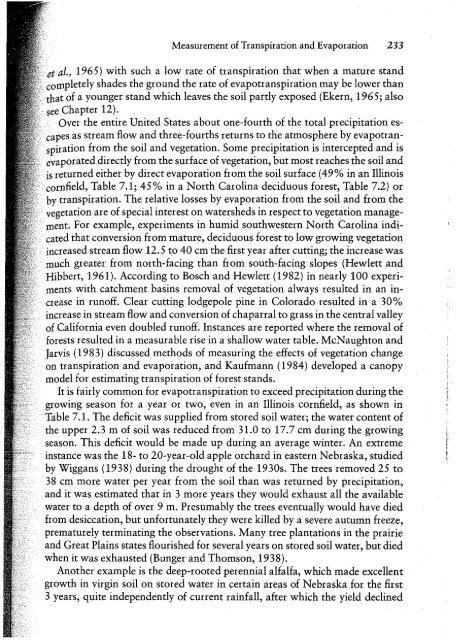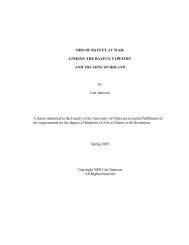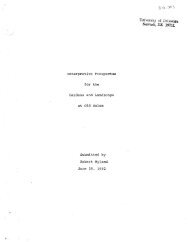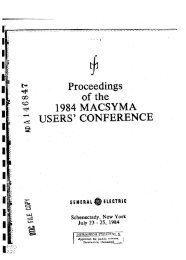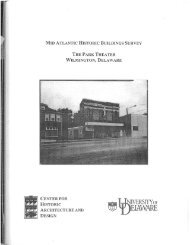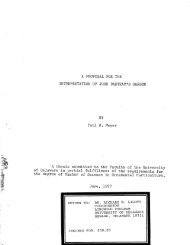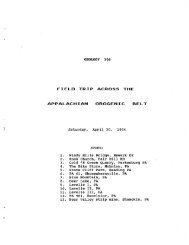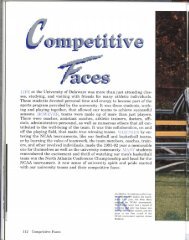Transpiration and the Ascent
Transpiration and the Ascent
Transpiration and the Ascent
You also want an ePaper? Increase the reach of your titles
YUMPU automatically turns print PDFs into web optimized ePapers that Google loves.
Measurementof<strong>Transpiration</strong><strong>and</strong> Evaporation 233<br />
eta!., 1965) with such a low rate of transpiration that when a mature st<strong>and</strong><br />
completely shades <strong>the</strong> ground <strong>the</strong> rate of evapotranspiration may be lower than<br />
that of a younger st<strong>and</strong> which leaves <strong>the</strong> soil partly exposed (Ekern, 1965; also<br />
see Chapter 12).<br />
. Over <strong>the</strong> entire United States about one-fourth of <strong>the</strong> total precipitation escapes<br />
as stream flow <strong>and</strong> three-fourths returns to <strong>the</strong> atmosphere by evapotranspiration<br />
from <strong>the</strong> soil <strong>and</strong> vegetation. Some precipitation is intercepted <strong>and</strong> is<br />
evaporated directly from <strong>the</strong> surface of vegetation, but most reaches <strong>the</strong> soil <strong>and</strong><br />
is returned ei<strong>the</strong>r by direct evaporation from <strong>the</strong> soil surface (49% in an Illinois<br />
cornfield, Table 7.1; 45% in a North Carolina deciduous forest, Table 7.2) or<br />
by transpiration. The relative losses by evaporation from <strong>the</strong> soil <strong>and</strong> from <strong>the</strong><br />
vegetation are of special interest on watersheds in respect to vegetation management.<br />
For example, experiments in humid southwestern North Carolina indicated<br />
that conversion from mature, deciduous forest to low growing vegetation<br />
increased stream flow 12.5 to 40 cm <strong>the</strong> first year after cutting; <strong>the</strong> increase was<br />
much greater from north-facing than from south-facing slopes (Hewlett <strong>and</strong><br />
Hibbert, 1961). According to Bosch <strong>and</strong> Hewlett (1982) in nearly 100 experiments<br />
with catchment basins removal of vegetation always resulted in an increase<br />
in runoff. Clear cutting lodgepole pine in Colorado resulted in a 30%<br />
increase in stream flow <strong>and</strong> conversion of chaparral to grass in <strong>the</strong> central valley<br />
of California even doubled runoff. Instances are reported where <strong>the</strong> removal of<br />
forests resulted ina measurable rise in a shallow water table. McNaughton <strong>and</strong><br />
Jarvis (1983) discussed methods of measuring <strong>the</strong> effects of vegetation change<br />
on transpiration <strong>and</strong> evaporation, <strong>and</strong> Kaufmann (1984) developed a canopy<br />
model for estimating transpiration of forest st<strong>and</strong>s.<br />
It is fairly common for evapotranspiration to exceed precipitation during <strong>the</strong><br />
growing season for a year or two, even in an Illinois cornfield, as shown in<br />
Table 7.1. The deficit was supplied from stored soil water; <strong>the</strong> water content of<br />
<strong>the</strong> upper 2.3 m of soil was reduced from 31.0 to 17.7 cm during <strong>the</strong> growing<br />
season. This deficit would be made up during an average winter. An extreme<br />
instance was <strong>the</strong> 18- to 20-year-old apple orchard in eastern Nebraska, studied<br />
by Wiggans (1938) during <strong>the</strong> drought of <strong>the</strong> 1930s. The trees removed 25 to<br />
38 cm more water per year from <strong>the</strong> soil than was returned by precipitation,<br />
<strong>and</strong> it was estimated that in 3 more years <strong>the</strong>y would exhaust all <strong>the</strong> available<br />
water to a depth of over 9 m. Presumably <strong>the</strong> trees eventually would have died<br />
from desiccation, but unfortunately <strong>the</strong>y were killed by a severe autumn freeze,<br />
prematurely terminating <strong>the</strong> observations. Many tree plantations in <strong>the</strong> prairie<br />
<strong>and</strong> Great Plains states flourished for several years on stored soil water, but died<br />
when it was exhausted (Bunger <strong>and</strong> Thomson, 1938).<br />
Ano<strong>the</strong>r example is <strong>the</strong> deep-rooted perennial alfalfa, which made excellent<br />
growth in virgin soil on stored water in certain areas of Nebraska for <strong>the</strong> first<br />
3 years, quite independently of current rainfall, after which <strong>the</strong> yield declined


